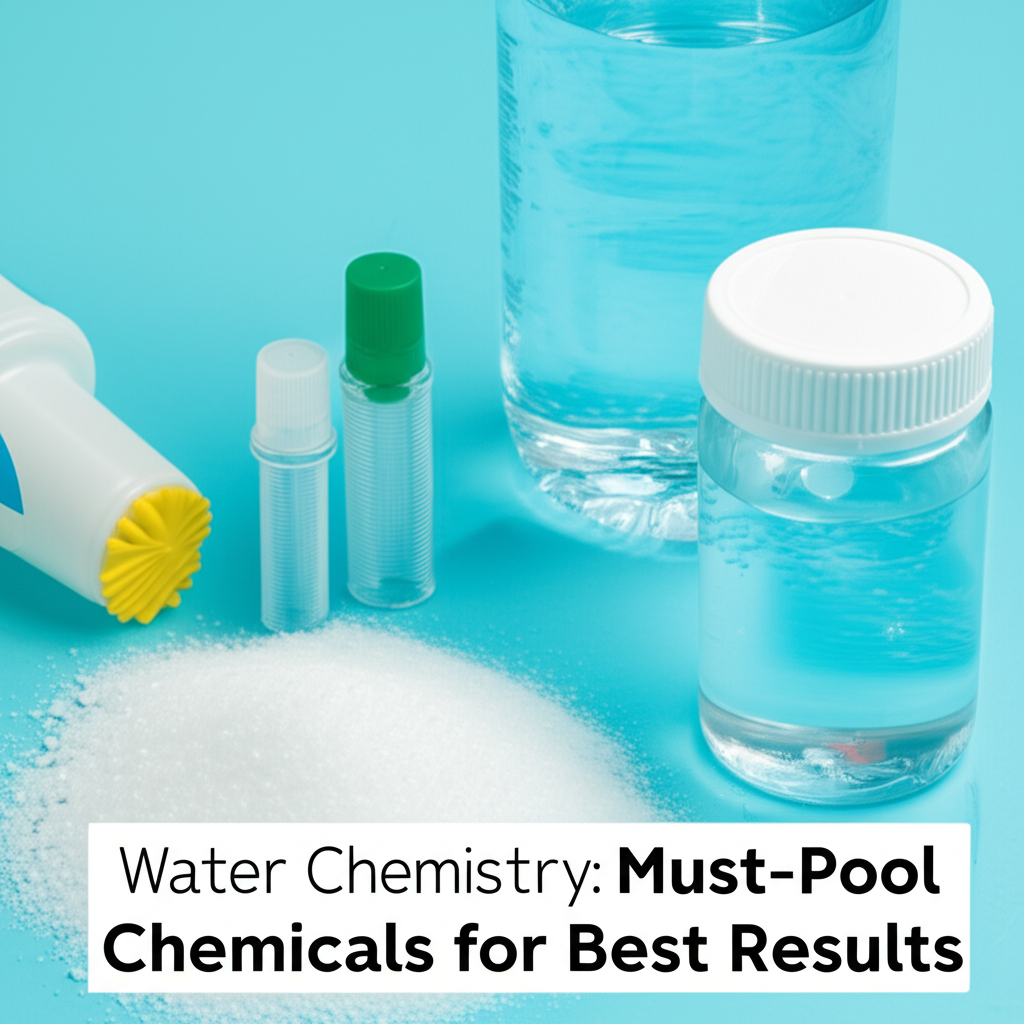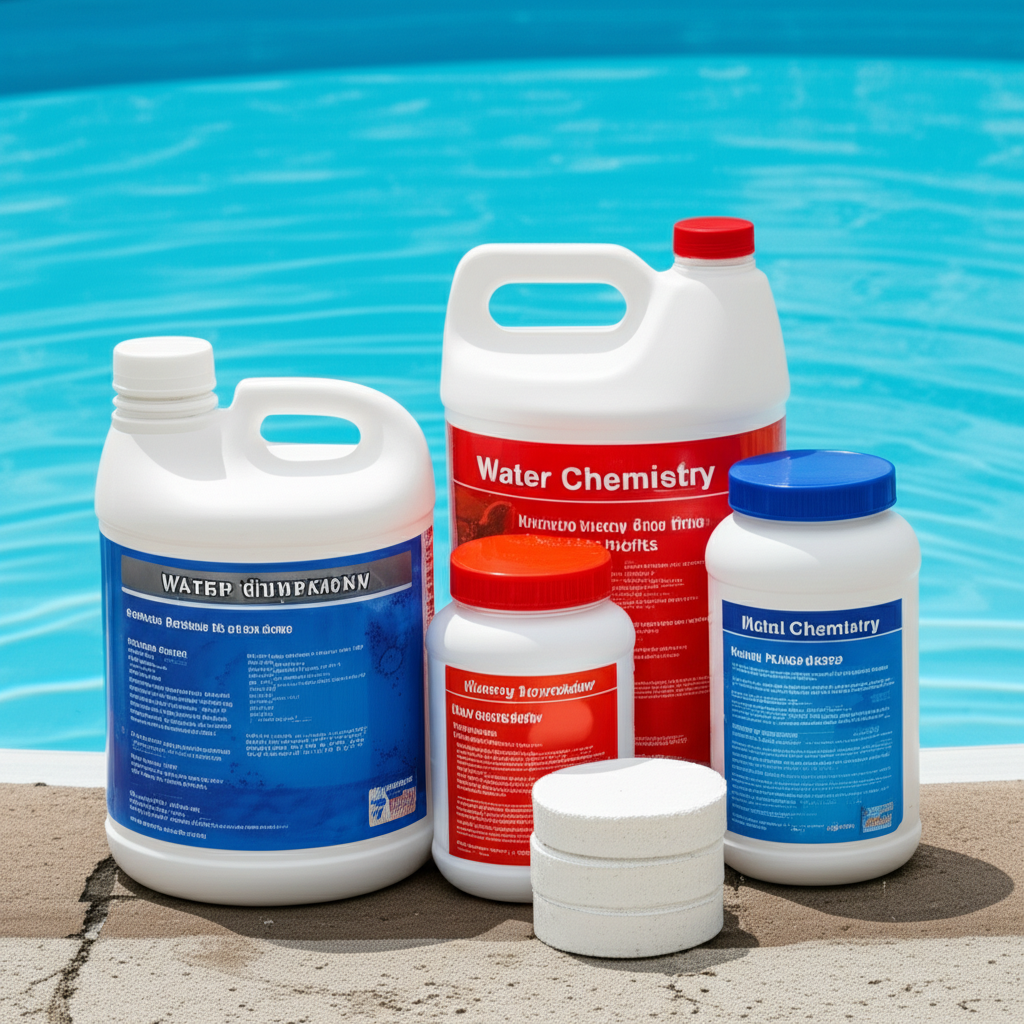- Why Optimal Pool Water Chemistry Matters
- The Foundation of Pool Health: Essential Pool Chemicals
- 1. Sanitizers: The Germ Killers
- 2. pH Increaser & Decreaser: The Comfort Controllers
- 3. Total Alkalinity Increaser: The pH Buffer
- 4. Calcium Hardness Increaser: The Equipment Protector
- 5. Cyanuric Acid (CYA): The Sunscreen for Chlorine
- 6. Algae Preventatives & Cloudiness Solutions
- Achieving Optimal Water Chemistry: A Consistent Routine
- Final Thoughts
Water Chemistry is the invisible guardian of a pristine swimming pool, ensuring not only its sparkling appearance but also the safety and comfort of everyone who takes a dip. Achieving and maintaining optimal water balance is not a mystical art, but a scientific endeavor requiring the right knowledge and a specific set of tools – primarily, a carefully selected arsenal of essential pool chemicals. Neglecting the intricate balance of your pool’s chemistry can lead to a host of problems, from skin and eye irritation to equipment corrosion, un hygienic water, and costly repairs. Understanding these fundamental chemical components is the bedrock of effective pool maintenance and the key to unlocking the full enjoyment of your aquatic oasis.
Why Optimal Pool Water Chemistry Matters
Beyond just aesthetics, balanced pool water is crucial for several reasons. Firstly, it ensures swimmer comfort. Imbalanced pH levels can cause stinging eyes, dry skin, and faded swimsuits. Secondly, it protects your investment. Corrosive water can damage pool liners, filters, heaters, and other expensive equipment, leading to premature wear and tear. Thirdly, and most critically, proper water chemistry is paramount for health and safety. The right balance allows sanitizers to work effectively, destroying harmful bacteria, viruses, and algae that can cause recreational water illnesses. A sparkling clean pool isn’t just inviting; it’s a healthy one.
The Foundation of Pool Health: Essential Pool Chemicals
Maintaining your pool’s health requires a consistent approach to its chemical balance. Here are the must-have pool chemicals for achieving the best results:
1. Sanitizers: The Germ Killers
Chlorine (granular, tablet, liquid): This is the most common and effective sanitizer, working to kill bacteria, viruses, and algae. It comes in various forms like stabilized chlorine (with Cyanuric Acid) and unstabilized (shock chlorine).
Ideal Range: Free Chlorine: 1-3 ppm (parts per million).
Consequences of Imbalance: Too low leads to algae and bacteria growth; too high can cause skin/eye irritation and strong odor.
Bromine: An alternative sanitizer, particularly popular for spas and indoor pools due to its stability at higher temperatures and less potent odor.
Ideal Range: 3-5 ppm.
2. pH Increaser & Decreaser: The Comfort Controllers
pH measures how acidic or basic your pool water is. It indirectly affects the effectiveness of your sanitizer and swimmer comfort.
pH Increaser (Soda Ash / Sodium Carbonate): Used to raise low pH levels.
Ideal Range: 7.4-7.6 (acceptable 7.2-7.8).
Consequences of Imbalance: Low pH causes corrosion, eye/skin irritation, and rapidly depletes alkalinity.
pH Decreaser (Muriatic Acid / Sodium Bisulfate): Used to lower high pH levels.
Consequences of Imbalance: High pH reduces sanitizer effectiveness, causes cloudy water, and scale formation (calcium deposits).
3. Total Alkalinity Increaser: The pH Buffer
Alkalinity Increaser (Sodium Bicarbonate / Baking Soda): Total Alkalinity (TA) stabilizes your pH, acting as a buffer against drastic pH shifts. It’s often called the “pH bodyguard.”
Ideal Range: 80-120 ppm.
Consequences of Imbalance: Low TA causes pH to “bounce” wildly, making it hard to maintain balance; high TA can lead to cloudy water and difficulty adjusting pH.
4. Calcium Hardness Increaser: The Equipment Protector
Calcium Hardness Increaser (Calcium Chloride): This chemical raises the calcium level in your pool water. Properly balanced calcium prevents water from becoming corrosive or scale-forming.
Ideal Range: 200-400 ppm (fiberglass/vinyl pools can tolerate lower, up to 250 ppm).
Consequences of Imbalance: Low calcium hardness makes water “hungry” for calcium, leading it to leach from plaster, grout, and equipment. High calcium hardness causes scale formation on surfaces and equipment, leading to cloudy water.
5. Cyanuric Acid (CYA): The Sunscreen for Chlorine
Cyanuric Acid (Stabilizer): Essential for outdoor pools, CYA protects chlorine from degradation by the sun’s UV rays, making your sanitizer last longer.
Ideal Range: 30-50 ppm (up to 80 ppm for saltwater pools).
Consequences of Imbalance: Low CYA means chlorine dissipates rapidly; high CYA can reduce chlorine effectiveness, essentially “locking it up.”
6. Algae Preventatives & Cloudiness Solutions
Algaecide: While chlorine kills algae, algaecides are supplemental treatments for prevention or targeted treatment of persistent algae problems.
Flocculants/Clarifiers: These products help clear cloudy water by clumping tiny particles together, making them large enough for your filter to catch or to settle on the bottom for vacuuming.
Achieving Optimal Water Chemistry: A Consistent Routine
The key to a consistently beautiful and healthy pool lies in routine testing and adjustment of your pool chemicals*.
1. Test Regularly: Use reliable test strips or a liquid test kit 2-3 times per week, especially during heavy use or hot weather.
2. Adjust Systematically: Always adjust alkalinity first, then pH, then calcium hardness. Add chemicals slowly, one at a time, allowing them to circulate before retesting and adding the next.
3. Read Labels: Always follow the manufacturer’s instructions for dosage and application of all chemicals.
4. Shock Your Pool: Periodically “shock” your pool (add a high dose of unstabilized chlorine) to destroy accumulated contaminants, chloramines (spent chlorine), and stubborn algae.
Final Thoughts
Understanding your pool’s water chemistry might seem daunting at first, but with a basic grasp of these essential pool chemicals and a consistent maintenance routine, you’ll be well on your way to enjoying a safe, sparkling, and inviting swimming experience all season long. Remember, your pool is a complex ecosystem, and maintaining its delicate balance is an ongoing commitment that pays off with countless hours of enjoyment and peace of mind.




